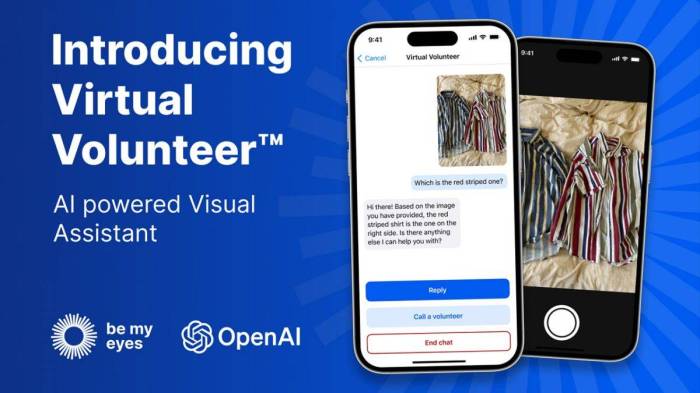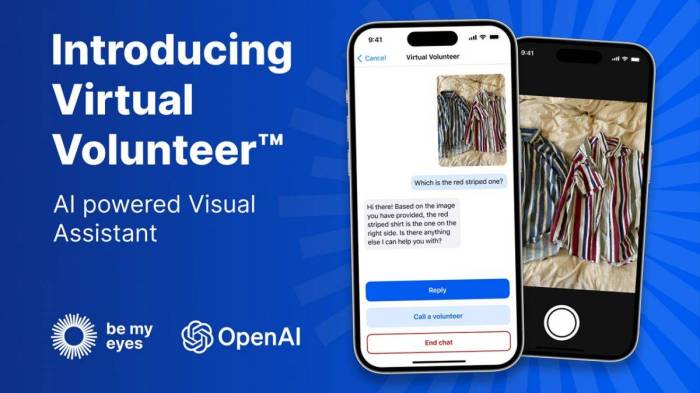Be my eyes app uses openai gpt 4 help visually impaired – Be My Eyes App Uses OpenAI GPT-4 to Help Visually Impaired, a revolutionary partnership that leverages the power of artificial intelligence to empower visually impaired individuals. The Be My Eyes app, known for connecting visually impaired users with sighted volunteers, is taking accessibility to a whole new level with the integration of GPT-4.
This powerful language model enhances the app’s capabilities, offering a more intuitive and comprehensive experience for users.
GPT-4’s advanced natural language processing skills allow it to understand complex requests and generate detailed descriptions of visual information, bridging the gap between the sighted and visually impaired worlds. Imagine a user needing help navigating a crowded grocery store; with GPT-4 integration, they can simply point their phone’s camera at the aisle and receive a clear, concise verbal description of the products available.
This technology has the potential to transform the lives of visually impaired individuals, empowering them to participate more fully in everyday activities.
Be My Eyes
Be My Eyes is a groundbreaking mobile app that empowers visually impaired individuals to navigate the world with greater independence. It serves as a bridge between those who are visually impaired and a global community of sighted volunteers, fostering a sense of connection and support.
The App’s Mission and Function
Be My Eyes’ mission is to create a world where visual impairment is no longer a barrier to living a full and independent life. The app achieves this by connecting visually impaired users with sighted volunteers through live video calls.
When a visually impaired user needs assistance with a task, they can initiate a call, and a volunteer will be able to see what the user sees through their smartphone’s camera. Volunteers can then provide real-time guidance, helping users with tasks such as reading labels, identifying objects, navigating unfamiliar environments, and even preparing meals.
Integrating GPT-4 into Be My Eyes
Imagine a world where visually impaired individuals can navigate their surroundings with ease, access information instantly, and interact with the world around them in a more intuitive and empowering way. GPT-4, with its advanced language understanding and generation capabilities, holds immense potential to revolutionize the Be My Eyes app, creating a truly transformative experience for visually impaired users.
Obtain direct knowledge about the efficiency of paris e scooter voting ban through case studies.
GPT-4’s Role in Enhancing User Interaction
GPT-4 can significantly enhance user interaction within the Be My Eyes app by providing real-time assistance and information. This integration allows users to request information about their surroundings, understand complex visual scenes, and receive helpful guidance in various situations.
- Scene Description:GPT-4 can analyze images captured by the user’s smartphone camera and provide detailed, comprehensive descriptions of the scene. This includes identifying objects, colors, shapes, and spatial relationships, offering a clear understanding of the user’s environment.
- Object Recognition:Users can ask GPT-4 to identify specific objects within a scene, such as identifying the brand of a product, the color of a shirt, or the type of flower in a garden. GPT-4 can accurately recognize and label objects based on its vast knowledge base.
- Text Recognition:GPT-4 can extract text from images, allowing users to read labels, signs, menus, or any other printed material. This enables them to access information that might otherwise be inaccessible.
- Actionable Guidance:GPT-4 can provide actionable guidance based on visual input. For instance, if a user is trying to find a specific item in a grocery store, GPT-4 can identify the aisle and provide directions to reach it. Similarly, it can assist with tasks like reading a recipe, identifying a bus stop, or navigating a crowded room.
Translating Visual Information into Verbal Descriptions
GPT-4’s ability to understand and translate visual information into natural language is a key feature that enhances the Be My Eyes experience. It can provide detailed and accurate descriptions of scenes, objects, and text, making it easier for visually impaired users to comprehend their surroundings.
- Detailed Descriptions:GPT-4 can generate rich and descriptive narratives, providing context and clarity to the user’s visual input. For example, instead of simply saying “a red car,” GPT-4 might describe it as “a bright red sports car with a black spoiler and tinted windows.” This level of detail provides a more comprehensive understanding of the scene.
- Simplified Language:GPT-4 can tailor its language to the user’s preferences, using clear and concise descriptions that are easy to understand. This is particularly helpful when describing complex scenes or objects that may require specialized vocabulary.
- Contextual Awareness:GPT-4 can consider the context of the user’s request and provide descriptions that are relevant and helpful. For instance, if a user asks “What is on the table,” GPT-4 will identify and describe the objects on the table, rather than providing a general description of the entire room.
Enhancing Accessibility and Independence
The integration of GPT-4 into Be My Eyes promises to revolutionize the way visually impaired individuals interact with the world around them, empowering them with greater accessibility and independence. By leveraging the advanced capabilities of GPT-4, the app can cater to a broader range of visual impairments and provide more comprehensive assistance with everyday tasks.
Expanding Accessibility for Diverse Needs
GPT-4’s ability to understand and respond to complex language and visual information opens up new possibilities for Be My Eyes. Here are some key areas where this integration can significantly enhance accessibility:
- Understanding nuanced descriptions:GPT-4 can interpret detailed descriptions of objects, scenes, and environments, allowing visually impaired users to receive more accurate and helpful information. This is especially crucial for individuals with low vision who might struggle with traditional image recognition tools.
- Handling complex tasks:GPT-4’s advanced reasoning capabilities enable it to assist with more intricate tasks, such as navigating unfamiliar environments, identifying specific products in a grocery store, or even providing assistance with cooking or household chores.
- Multilingual support:GPT-4’s multilingual capabilities allow Be My Eyes to support a wider range of users globally, breaking down language barriers and enabling individuals to connect with volunteers from different countries.
Empowering Users with Increased Independence
The enhanced capabilities of GPT-4 can significantly contribute to the independence of visually impaired individuals. By providing more accurate and comprehensive information, the app can empower users to:
- Navigate their surroundings with confidence:GPT-4 can provide detailed descriptions of environments, allowing users to confidently navigate public spaces, explore new places, and participate in social activities.
- Manage daily tasks more effectively:With GPT-4’s assistance, users can independently complete tasks like grocery shopping, preparing meals, or managing their finances, reducing reliance on others and increasing their autonomy.
- Engage with the world on their own terms:By providing access to information and assistance, GPT-4 empowers users to actively participate in their communities and pursue their interests, leading to a more fulfilling and independent life.
Ethical Considerations and Challenges
While the potential benefits of integrating GPT-4 into Be My Eyes are immense, it is crucial to address ethical considerations and potential challenges:
- Privacy and data security:The use of AI in accessibility technology raises concerns about the privacy and security of user data. It is essential to ensure that user information is handled responsibly and securely to prevent misuse or unauthorized access.
- Bias and fairness:AI models can inherit biases from the data they are trained on. It is crucial to ensure that GPT-4 is trained on diverse datasets to minimize bias and promote fairness in its interactions with visually impaired users.
- Accessibility for all:It is important to ensure that the integration of GPT-4 does not exclude individuals with certain types of visual impairments or who may not have access to the necessary technology. Accessibility for all is paramount.
Future Possibilities and Innovations: Be My Eyes App Uses Openai Gpt 4 Help Visually Impaired

The integration of GPT-4 into the Be My Eyes app opens up a world of possibilities for enhancing accessibility and independence for visually impaired individuals. This powerful AI technology can be leveraged to create new features and functionalities that go beyond the current capabilities of the app, revolutionizing how visually impaired users interact with their surroundings.
Real-Time Image Analysis and Voice-Based Assistance
GPT-4’s ability to analyze images in real-time can be harnessed to provide more comprehensive and informative assistance to visually impaired users. This could include:
- Describing complex scenes: GPT-4 can provide detailed descriptions of scenes, including objects, colors, textures, and spatial relationships, allowing users to understand their surroundings more fully.
- Identifying specific objects: Users could request GPT-4 to identify specific objects in their field of vision, such as identifying products in a grocery store or recognizing faces in a crowd.
- Navigational guidance: GPT-4 could analyze images to provide real-time navigation assistance, guiding users through unfamiliar environments by identifying obstacles, landmarks, and pathways.
GPT-4’s natural language processing capabilities can also be integrated to enhance voice-based assistance:
- Personalized responses: GPT-4 can learn individual user preferences and provide tailored responses, ensuring a more intuitive and personalized user experience.
- Contextual understanding: GPT-4 can understand the context of a user’s request and provide more relevant and accurate information, such as identifying the specific product a user is looking for in a store based on previous conversations.
- Proactive assistance: GPT-4 can proactively offer assistance based on user context, such as suggesting relevant information or actions based on the user’s location or current activity.
Enhanced User Experience and New Possibilities
GPT-4’s advanced capabilities can significantly enhance the user experience for visually impaired individuals:
- Increased accessibility: GPT-4 can be used to make websites and mobile applications more accessible by providing alternative text descriptions for images and videos.
- Improved communication: GPT-4 can be used to translate spoken language into text and vice versa, facilitating communication with individuals who are deaf or hard of hearing.
- Personalized learning: GPT-4 can be used to create personalized learning experiences for visually impaired individuals, tailoring educational content to their specific needs and learning styles.
Impact on Human Volunteers, Be my eyes app uses openai gpt 4 help visually impaired
The integration of GPT-4 into the Be My Eyes app could significantly impact the role of human volunteers in the Be My Eyes community. While GPT-4 can automate many tasks, it’s important to note that human volunteers bring unique perspectives and capabilities:
- Emotional intelligence: Human volunteers can provide emotional support and empathy, which are crucial for visually impaired individuals who may face challenges and frustrations in their daily lives.
- Contextual understanding: Human volunteers can provide more nuanced and context-sensitive assistance, understanding the nuances of social situations and cultural contexts that AI may struggle with.
- Human connection: The connection and camaraderie between human volunteers and visually impaired users are invaluable, fostering a sense of community and shared experiences.
Rather than replacing human volunteers, GPT-4 can augment their efforts, allowing them to focus on more complex and nuanced tasks that require human judgment and empathy.





